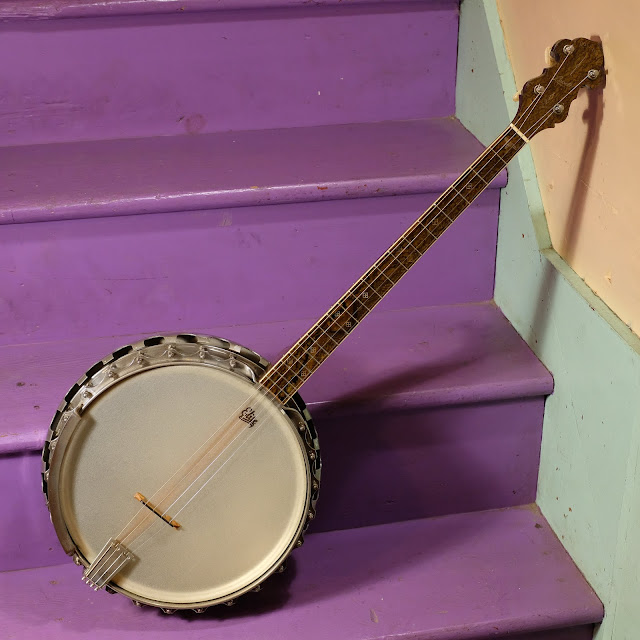1920s Leedy Collegian Resonator Tenor Banjo
This is the cleanest and most-complete Leedy/Ludwig I've had through the shop. It's also the craziest-looking with its "petrified-wood-look" celluloid fretboard veneer. The company started building banjos around 1925 and so this one probably dates from the late 1920s. It's a top-tension model which keeps the look clean and simplifies adjusting the tension on the head as you don't need to remove the resonator to get at the hooks. In the era of skin heads (this one has its original one, which I've stowed in its case), constant adjustment was a must, so that was a huge advantage back in the day.
These are loud, proud, punchy, and fiery instruments. They will cut. This one is getting close to that "resonator Bacon, ear-punching" vibe. For a more-folksy player, muting is a must. I've added a tiny bit of damping behind the head to reduce overtones, but it's basically full-on at the moment. It's well-suited to Dixieland or trad-jazz use but would serve excellently for a Celtic or old-time GDAE player needing some guts to punch through fiddles. I still think these sound best tuned in the CGDA range of pitches, though.
It's entirely original except for the new head and features original geared Grover tuners, a nice armest, adjustable tailpiece, and all-metal rim and resonator construction. It has a sort-of integrated "mini-donut" tonering because of that.
Work included: a fret level/dress, side dots install, cleaning, new Remo Renaissance/Elite synthetic head, and a good setup. I re-used the original 1/2" bridge. While the neck had a tiny 1/64" amount of warp to it, that was taken-out via the fret level/dress job and so it plays perfectly with 1/16" action at the 12th fret, strung with 32w-9 gauges for CGDA standard tuning.
Scale length: 23"
Nut width: 1 1/8"
String spacing at nut: 15/16"
String spacing at bridge: 1 3/8"
Nut width: 1 1/8"
String spacing at nut: 15/16"
String spacing at bridge: 1 3/8"
Head diameter: 11" with new Remo Renaissance/Elite head
Side depth: 4" overall
Rim wood: nickel-plated steel, I believe
Neck wood: two-piece maple
Fretboard: maple with celluloid veneer
Neck wood: two-piece maple
Fretboard: maple with celluloid veneer
Neck shape: flat board medium C/V hybrid rear
Bridge: maple/ebony 1/2"
Nut: original bone
Condition notes: it's very clean throughout, though the plating on the resonator has a little blem here and there and it does have minor usewear.
It comes with: its original hard case, original skin head (in good shape), and a tensioning wrench for the hooks.
The muddy green/brown celluloid has a bit of a gold-ish sparkle to it that makes it look like petrified wood or... an anaconda! There are engraved/pressed details for fret markers and logo.
During setup, I added a shim at the top of the heel that juts against the tension hoop. Check out the cool way the tension hoop's edge was bent and welded together, though, near the neck -- that's a great look.
The original bridge, with its 4-foot configuration, looks snazzy.
The adjustable tailpiece is a must on this instrument as the tension hoop is not flush with the head.
Nice, original, ivoroid-buttoned Grover tuners are at the headstock. The neck is two-piece maple with a center stripe.
A little bit of engraving at the edge of the resonator is a nice touch -- and so is the heel cap.
The armrest is slip-on/slip-off. All of the hook/nuts are original.
The resonator comes off with one bolt.
The neck brace is ingenious and simple. It swivels to get out of the way and has a spoke-adjustable nut on the end that tightens-up against the metal of the rim.
























Comments
Mine's strung in GDAE with a D'Addario EJ83i set; it sounds really nice on the bottom strings for tunes in Dm and Gm. Being able to easily remove the resonator for a drier sound is useful too - I usually take the resonator off if I'm playing amplified.